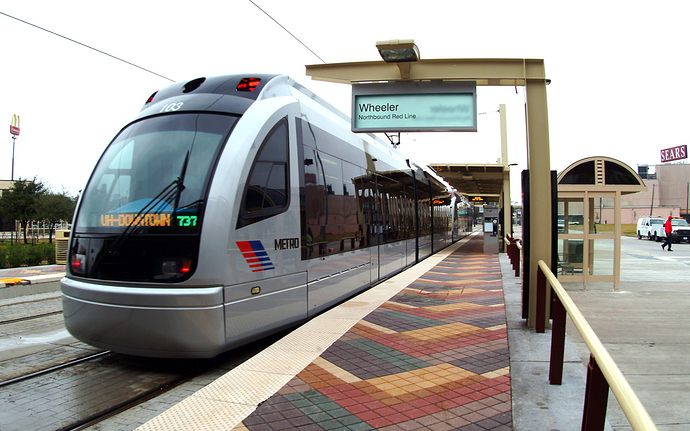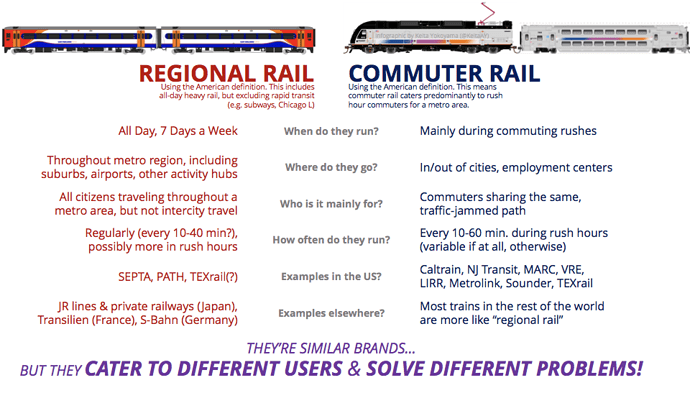That’s what some folks do to everything it seems.
I agree, but I also think this goes both way. Just like people go “not in my backyard!!” for no reason other than because they “feel like it’ll be bad for them”, the same, faulty ideas of truthiness goes for YIMBY people too…
…but enough about feeling for a solution.
What would it take, exactly, if you were to try to make a startup for a regional rail/express BRT route between Fuquay and Raleigh (or some other route)?
It would take commitment and less B.S. to make it happen, BRT to Fuquay and Raleigh or RDU to Garner lets say…Something anyway. Driving may be better for some, but it will be only a matter of time before traffic becomes a real nightmare in the long run. the “not in my backyard” theme only last for so Long, and Change is only inevitable.
I think it might be useful to be clearer about the differences between light rail and commuter rail, which are two distinctly different things.
Light rail typically runs on streets, on space that otherwise would or could accommodate car traffic, as in the picture above. It’s thus similar to streetcars or trams in that light rail will have smaller cars, going more slowly, and making more frequent stops, over shorter distances.
Commuter rail is essentially what most people would envision when they hear the word “train.” It will have larger cars, going faster, and making less frequent stops over longer distances. More prosaically, commuter rail goes “choo choo” while light rail typically goes “ding ding,” if that helps.
The line from F-V to DTR is about 17+ miles, runs through an extremely low-population area, has almost no at-grade crossings, and, most importantly, has train tracks. There will never, ever, ever, ever be “light rail” along this line. The end.
Now, could there be commuter rail along this line? From a technical standpoint, it’s definitely feasible. You really could have a commuter rail running from FV to DTR if one were so inclined. But how likely is that in the time period in which any of us will be alive? Right now, the big rail project in the works is a commuter line that would connect DTR to Durham (a vastly, vastly bigger city), with highly valuable stops in Cary and RTP, plus a few others, along the way. It’s expected to cost about $1 billion and if we’re really, really lucky, it might get finished by 2027, but probably not that soon.
Given how difficult it’s been to get this exceedingly valuable project off the ground (or on the ground, as it were), at what point would it become politically feasible to spend close to $1 billion in today’s money to build a commuter rail line that would connect the quite small city of F-V to DTR, with very few stops in between? My guess is never, or at least certainly not in any of our lifetimes.
Now, running regional rail along this line is another viable possibility. Or you could divert more freight rail to this line to free up more space for people on the commuter rail line. (Or both, I guess.) But each of those is yet another entirely different thing from either light rail or commuter rail.
That’s true. My guess is that many of us (myself included) should’ve been saying “regional rail” instead of “commuter rail” in this sort of context, then. Thanks for the correction; I think it’s too easy to forget to make the distinction in the U.S. that regional rail is different from commuter rail.
Plus, one just serves commuters in rush hour; the other is an actual, radically new way to get around at any time of the day and any day of the week. Looks like Boston is struggling to make this distinction, too. (Also see the full report or the infographic I made below)
If you really want to connect Fuquay to Raleigh by rail, then I’m getting the vibe that creating a Triangle-wide regional rail system is the way to go…
I wonder how much it would cost to put 7 new miles of rail track and a new rail station at RDU. Weren’t they going to re-design the the car rental area? Maybe they can make it a transportation hub like many other cities. Rail station at the bottom, new car rental hub on top, and even more parking on top of that.
The average cost to building a mile of new train track is $2 million but let’s say it’s $7 million. Isn’t $50 million for a commuter rail that stops by or near the airport a pretty good deal? Especially in 50 years from now when the population has doubled and it will take 2 hours+ to drive from DTR to DTD?
A station on the RDU property itself, although ideal, would be super expensive. It essentially require a WYE to be built off of the rail line in the Morrisville area and weave it into the fabric of the RDU access roads and ideally into the bottom of the parking deck between the terminals. A more likely alternative would be to build a station serving Morrisville near the intersection of Airport Blvd and Chapel Hill Road and have a dedicated shuttle bus between the terminals and the station.
Looks like they still are! RDU is planning to build a “Consolidated Rental Car Facility” (CONRAC), among other things. See future building L-5 on this finalized sheet drawing that the FAA approved (warning: large PDF).
While they were deciding on that option, though, it looks like RDU eliminated a design that included an in-airport people mover (see Alternative 8). It looks like they got rid of it since that sort of system doesn’t make much sense if it’s only around the airport…
Of course, that doesn’t mean you can’t have a rail link that also blends into both existing and proposed buildings. But you still need additional approval from the FAA if you want the regional (not just commuter) rail system to go through the airport, though, on top of the commercial/safety arguments and environmental studies you gotta have no matter what.
On a more general note, though, having a regional rail line that connects to RDU (by bus like @CanesFan said, or by ecoPRT) could make the case and demand for expanding to Fuquay and elsewhere too.
In May, 1961, President Kennedy set the goal to put a man on the moon by the end of the decade. Barely 8 years later it happened. Now, how long have we been talking about the commuter rail between Raleigh and Durham? And, we can’t even imagine it making a 2027 delivery date when we already have the tracks? #pathetic
I firmly believe that we have so many self inflicted barriers in getting almost every major public project (transit, etc) that it is nearly impossible. I may be wrong here, but if it were all privately funded the process would move along at a much faster pace. (Just look at how fast 540 was built between 54 and Holly Springs). Whereas the Beltway around Winston Salem has been discussed my entire lifetime and it just beginning to get started on the east side of town. Had it been a toll road, it would have been built long before now.
My concern is that, if we privately fund rail, rider costs could spiral out of control. If a rail system is public, the presumption would be that rider fees would supplement the operating costs, but they would also be funded through taxes, sort of like how roads are maintained with tax dollars, not user fees.
I think it’s also important to remember that, in the 1960s, the highest marginal tax rates on the very highest earnings was much, much higher. There simply was more available revenue for infrastructure funding at the federal level.
I completely agree. My point is that with any type of government funding there are a million obstacles to overcome. We have created a system that makes it nearly impossible to get anything built in a timely manner.
I have no insight, but from what I understand the Chinese are able to build these high speed rail lines (and clean power plants, etc, etc, etc) very quickly because they don’t have a million self imposed obstetricals in the way of getting things built.
I actually made a mistake in my post. I meant to say if the rail was privately funded, rider costs could spiral out of control because a private system’s operating cost would have to be fully funded by its riders, while roads are not. In my opinion, it would be set up for failure.
It seems to me that we are just now getting to the point where the commuter train is needed and also would be used enough to be successful. 10 years ago I would not have agreed or voted for commuter train. I probably would not have even 5 years ago. And I bet a large portion of residents in this area think similarly. Educating the public and making sure they understand the benefits of projects is very important.
I get the frustration, but during those years NASA’s funding reached as high as 4.4% of the entire Federal budget (which would be $>50B/yr in today’s dollars adjusted for inflation, and >$200B/yr as a percentage of the current federal budget). The situations can’t really be compared.
I think the point really is the need for political will.
I don’t mean to be snarky but while this is a lovely thread, I see no political will going towards anything discussed here. The same thinking can be applied to lots of other topics around town.
Hmmm??? I wonder how they funded that?
http://forbestadvice.com/Money/Taxes/Federal-Tax-Rates/Historical_Federal_Top_Marginal_Tax_Rates_History_Graph.html
I haven’t commented on this before, but as someone who grew up in Fuquay and went to Raleigh every chance I got (and still do when I’m visiting my parents) I think we’re a few decades from a rail line really being viable. The traffic into DTR from 401 or Lake Wheeler isn’t bad enough to get people out of their cars. I actually used to commute through DTR instead of 440 because it was easier at rush hour. I think it would be prudent to secure the right of way (or whatever needs to be done to make this possible in the future) but building out a whole system to Fuquay doesn’t strike me as a great use of transit dollars until mid century.
If I were going to do phasing of Regional Rail in the triangle, this is how I would do it.
- Garner to Durham. 20 minute peak / 60 minute off peak frequency.
- Extend Garner-Durham trains to Clayton.
- Wake Forest to Durham. 20/60 Wake Forest to Raleigh, which combines with Clayton line to make 10/30 Raleigh to Durham, and timed to allow wrong-way transfers from Clayton to Wake Forest and vice-versa by changing trains in Raleigh.
- Extend Clayton-Durham trains to Hillsborough/Mebane.
- Double frequency on Garner and Wake Forest lines to 10/30, which means 5/15 between Raleigh and Durham.
- Zebulon to Raleigh. 20/60, timed transfers to Durham in downtown Raleigh.
- Fuquay-Varina to Raleigh. 20/60, timed transfers to Durham in downtown Raleigh.
- Further extensions (Franklinton, Wilson, Selma)
Fuquay is at the bottom of the list for trains, for all the reasons everybody else has mentioned.

